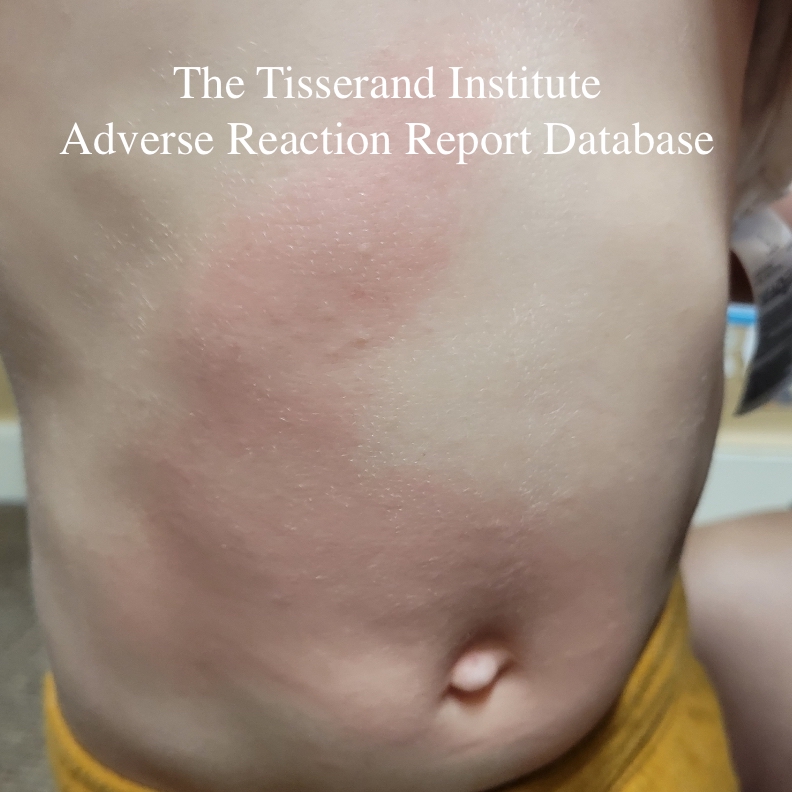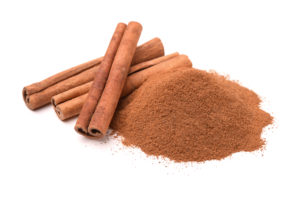As you may know, the Tisserand Institute manages an Adverse Reaction Database where we collect mostly skin reactions caused by using essential oils. Anyone can submit a report, ideally with photos of the reaction. While we’re not trying to collect all adverse reactions, we look at what did happen in each particular case, and how it might have been be avoided. After all, any such event can teach us how to prevent future issues. One such case was submitted recently and we wanted to give it a bit more of a spotlight, as there is a lot that can be highlighted. This is the description of what happened:
 “This is a homemade repellent I purchased from a seller on Etsy. Full ingredients are: Water, Cedarwood, Lemongrass, Citronella, Cinnamon bark, Eucalyptus, Polysorbate 20.
“This is a homemade repellent I purchased from a seller on Etsy. Full ingredients are: Water, Cedarwood, Lemongrass, Citronella, Cinnamon bark, Eucalyptus, Polysorbate 20.
Immediately after applying to my 3.5 year old his skin started to get red. It got worse over the next 15-30 minutes and progressed to hives. He wasn’t itching and wasn’t bothered by it. His school washed his skin off with soap and water. The irritation began to subside and then completely went away. Was this a reaction that has permanently primed his immune system? Hopefully this didn’t cause permanent damage to him somehow (if that is even a thing?)”
The report was sent together with a picture of the child’s torso showing clear redness and urticaria.
Let’s take this opportunity to look at what can be done to prevent a nasty surprise like this, for all parties involved – the product manufacturer as well as the consumer.
What happened
In this situation the child suffered an adverse skin reaction after the product was applied. Fortunately there was no itching or pain involved, and the reaction subsided quickly, which suggests that it was most likely irritant and not allergic.
The most likely culprits would be Cinnamon bark and Lemongrass essential oils. Since the dilution is not known and neither are the exact proportions of essential oils in the product, it’s not possible to be more specific.
For the manufacturer
Selling your cosmetic creations on Etsy is not uncommon, as the website provides a solid marketplace for artisan creators. However, those creators are still responsible for the safety of their consumers as well for following local, state and national regulations as they apply to their product.
It’s important to make sure you keep your customers safe, and that you have product liability insurance cover in case an adverse reaction leads to litigation.
Information and labelling
Information on the product was taken from the seller’s page found based on the ingredient list provided in the report. These are the instructions given for the product on the manufacturer’s website:
“To use: Spray liberally on skin. Can also spray on clothing and hair for maximum protection.
***Cinnamon can cause skin irritation. Recommended not to use on children.***”
We could not verify if the same information is on the product itself, but images of the product suggest that this is not the case.
As a formulator/manufacturer, you want to be certain that any relevant safety warnings for the intended use are marked as clearly as possible to protect yourself from lawsuits. It goes without saying that you don’t want to cause harm to your customers, but people do not always pay attention to what is written on a website, which is why labelling requirements are very specific.
For cosmetics, the FDA requires warning statements to be on, or with, a product at point of sale, and not just on a website:
“Regulations require that “. A cosmetic not bearing a necessary warning statement may be considered misbranded under sec. 602(a) of the FD&C Act because it fails to reveal a fact “material … with respect to consequences which may result from the use of the article” .”
“Prominence: A warning statement must appear on the label prominently and conspicuously as compared to other words, statements or designs so that it is likely to be read by ordinary consumers at the time of purchase and use.”
Although the product in question is an insect repellent and is therefore regulated by the EPA and not the FDA, product safety is still paramount, and both Cinnamon bark and Lemongrass oil are potential allergens.
We do not have information on the total dilution of essential oils in the product, but let’s assume they are up to safety standard for application to the skin, especially if recommended to be done “liberally”. Both Cinnamon and Lemongrass need to be present within safety limits, which, for adults, would be 0.7% for Lemongrass and 0.1% for Cinnamon bark, and note that these are maximums. Not using this product on children is good advice, but would need to be stated on the label, and ideally, age range would be specified, such as under 6, 12 or 18.
Don’t be afraid to say “do not use for children” if you’re not sure whether the product is safe. Again, it’s for your protection as well as that of your customers. Your extra layer of protection is to make sure to go as low as you possibly can without losing efficacy, and to make sure that your consumer knows that the dilution is within safe limits.
Many small producers are not aware of safety regulations for essential oils, and some may simply choose to ignore them. In 2014 we published a report on the safety of Cinnamon bark oil, and a blogpost on common recommended dilutions for its use. Some essential oil sellers took note and made changes, but many did not.
Ingredients and formulation
 The listed ingredients are as previously stated: Water, Cedarwood, Lemongrass, Citronella, Cinnamon bark, Eucalyptus, Polysorbate 20.
The listed ingredients are as previously stated: Water, Cedarwood, Lemongrass, Citronella, Cinnamon bark, Eucalyptus, Polysorbate 20.
Formulators will know that Polysorbate 20 is an emulsifier that helps the essential oils to mix with the water, and for safety reasons this is an essential ingredient. Some consider it an unsafe ingredient, and the main concern is contamination from 1,4-dioxane. Traces of dioxane, which the EPA considers a probable human carcinogen, are formed during the manufacturing of polysorbates, but most manufacturers remove this through a process called vacuum stripping. Because polysorbate 20 is quite widely used in the food industry, this has been a focus of concern for the FDA, and so food grade polysorbate 20 is suggested for those who want to use it.
Although the FDA has not set maximum limits for dioxane, the consensus among regulators is that 10 ppm is a safe threshold for cosmetics (ICCR 2017, SCCS 2015). It’s also worth noting that dioxane is volatile, and in products applied to the skin, most of it will evaporate (Juhász and Marmur 2014). Polysorbates are not considered to present a risk of skin irritation or allergy (Anon. 1984).
Formulators will also notice the lack of a preservative in a product that contains presumably more than 90% of water. Any time you introduce water or a water-based ingredient into your product, you have to account for the fact that water = life, meaning that bacteria will grow unless you prevent them from doing so by using an effective preservation system.
It’s a common misconception that essential oils will work as preservatives as they have antibacterial effects, however they would have to be present at levels too high to be safe for skin application without irritation or allergy being all but certain. So either the concentration is too high to comply with the instructions of applying directly to the skin, or it’s too low to be effectively preserved. It’s also possible that there is a preservative, but it is not disclosed.
If you’re not comfortable using preservatives in your consumer formulas, the easiest solution is to not formulate with water. You can absolutely make sprayable oil-based preparations.
Summary for formulator:
- Make sure instructions, especially regarding to safety, are clear and available to the consumer when using the product.
- Make sure your product is safe both in terms of essential oil dilution guidelines and in terms of preservation or emulsification.
- Have a product liability insurance policy in case of adverse reaction.
The User
If you buy a product, it’s reasonable to assume that it was created with safety and efficacy in mind. And we tend to think that a small artisan production is inherently safer than huge industrial one – after all, it’s a labor of love. And in many cases, both of these apply.
However, when it comes to small children and other vulnerable populations, it may be safe to work under the premise of “consider unsafe unless stated otherwise”, especially if we don’t have specific information.
In this situation the parent did use the product in a way that was not recommended, though the warning does not seem to be present on the label of the product and is not very specific, as discussed above.
Summary for the user:
- Read instructions thoroughly
- Make sure to use child appropriate products clearly marked as such
First aid
If you experience a similar adverse reaction, you should wash the product off immediately with soap, and apply soothing unscented cream or gel afterwards to calm the inflamed skin. More here.
Hopefully this rundown has been useful and will help you navigate safety as it relates to finished products that you either make yourself, or buy from small manufacturers. And please don’t hesitate to submit a reaction that you yourself may have experienced for our database (https://tisserandinstitute.org/adverse-reaction-database/#home/add-adverse-reaction-report/), or share your thoughts on this particular matter by commenting below,
References
Anon. (1984). Final report on the safety assessment of polysorbates 20, 21, 40, 60, 61, 65, 80, 81, and 85, 3(5). https://journals.sagepub.com/doi/pdf/10.3109/10915818409021272
ICCR 2017. Considerations on Acceptable Trace Level of 1,4-Dioxane in Cosmetic Products.
Juhász, M. L. W., & Marmur, E. S. (2014). A review of selected chemical additives in cosmetic products. Dermatologic Therapy, 27(6), 317–322. https://doi.org/10.1111/dth.12146
SCCS 2015. The Report of the ICCR Working Group: Considerations on acceptable trace level of 1,4-dioxane in cosmetic products. https://ec.europa.eu/health/scientific_committees/consumer_safety/docs/sccs_o_194.pdf




Appreciative of your review and clarifications in regard to compostion of synergy and labeling. there are so many crafters of products without the knowledge-base of the chemistryof theessential oils and effects on skin. I can now see the importance of labeling and that information on usage should be on website and prodcut. thank you for you expertise.
Very interesting and most hepful information. Thank you